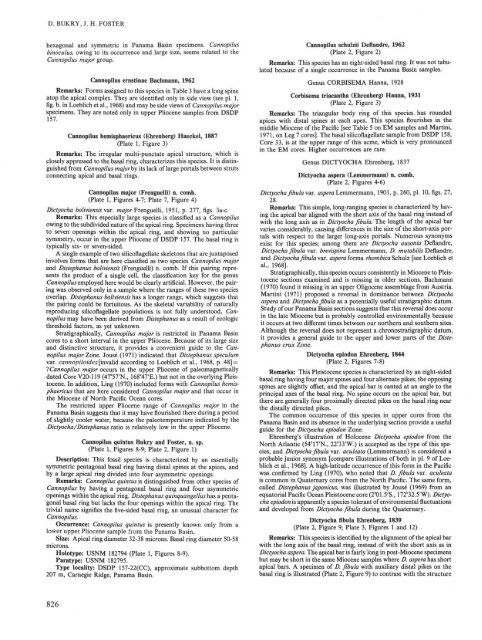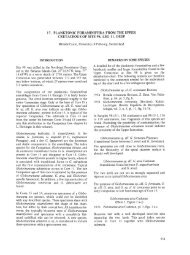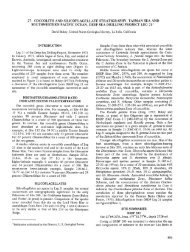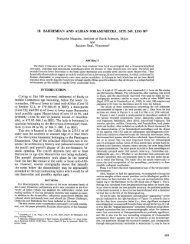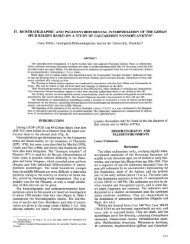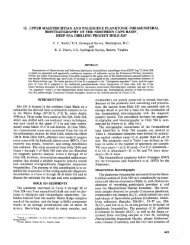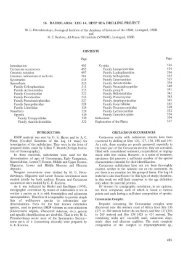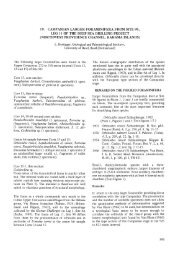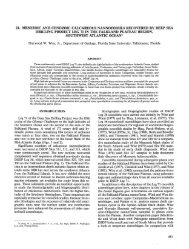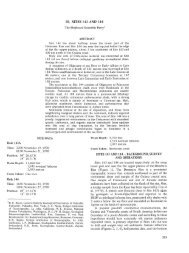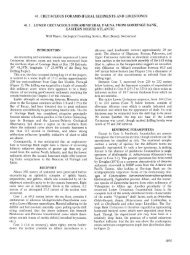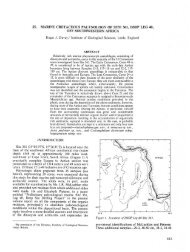1 - Deep Sea Drilling Project
1 - Deep Sea Drilling Project
1 - Deep Sea Drilling Project
You also want an ePaper? Increase the reach of your titles
YUMPU automatically turns print PDFs into web optimized ePapers that Google loves.
D.BUKRY, J. H.FOSTER<br />
hexagonal and symmetric in Panama Basin specimens. Cannopilus<br />
binoculus, owing to its occurrence and large size, seems related to the<br />
Cannopilus major group.<br />
Cannopilus ernstinae Bachmann, 1962<br />
Remarks: Forms assigned to this species in Table 3 have a long spine<br />
atop the apical complex. They are identified only in side view (see pi. 1,<br />
fig. b. in Loeblich et al., 1968) and may be side views of Cannopilus major<br />
specimens. They are noted only in upper Pliocene samples from DSDP<br />
157.<br />
Cannopilus hemisphaericus (Ehrenberg) Haeckel, 1887<br />
(Plate 1, Figure 3)<br />
Remarks: The irregular multi-punctate apical structure, which is<br />
closely appressed to the basal ring, characterizes this species. It is distinguished<br />
from Cannopilus majorby its lack of large portals between struts<br />
connecting apical and basal rings.<br />
Cannopilus major (Frenguelli) n. comb.<br />
(Plate 1, Figures 4-7; Plate 7, Figure 4)<br />
Dictyocha boliviensis var. major Frenguelli, 1951, p. 277, figs. 3a-c.<br />
Remarks: This especially large species is classified as a Cannopilus<br />
owing to the subdivided nature of the apical ring. Specimens having three<br />
to seven openings within the apical ring, and showing no particular<br />
symmetry, occur in the upper Pliocene of DSDP 157. The basal ring is<br />
typically six- or seven-sided.<br />
A single example of two silicoflagellate skeletons that are juxtaposed<br />
involves forms that are here classified as two species Cannopilus major<br />
and Distephanus boliviensis (Frenguelli) n. comb. If this pairing represents<br />
the product of a single cell, the classification key for the genus<br />
Cannopilus employed here would be clearly artificial. However, the pairing<br />
was observed only in a sample where the ranges of these two species<br />
overlap. Distephanus boliviensis has a longer range, which suggests that<br />
the pairing could be fortuitous. As the skeletal variability of naturally<br />
reproducing silicoflagellate populations is not fully understood, Cannopilus<br />
may have been derived from Distephanus as a result of ecologic<br />
threshold factors, as yet unknown.<br />
Stratigraphically, Cannopilus major is restricted in Panama Basin<br />
cores to a short interval in the upper Pliocene. Because of its large size<br />
and distinctive structure, it provides a convenient guide to the Cannopilus<br />
major Zone. Jousé (1971) indicated that Distephanus speculum<br />
var. cannopiloides [invalid according to Loeblich et al., 1968, p. 48] =<br />
1Cannopilus major occurs in the upper Pliocene of paleomagnetically<br />
dated Core V20-119 (47°57'N., 168°47'E.) but not in the overlying Pleistocene.<br />
In addition, Ling (1970) included forms with Cannopilus hemisphaericus<br />
that are here considered Cannopilus major and that occur in<br />
the Miocene of North Pacific Ocean cores.<br />
The restricted upper Pliocene range of Cannopilus major in the<br />
Panama Basin suggests that it may have flourished there during a period<br />
of slightly cooler water, because the paleotemperature indicated by the<br />
Dictyocha/Distephanus ratio is relatively low in the upper Pliocene.<br />
Cannopilus quintus Bukry and Foster, n. sp.<br />
(Plate 1, Figures 8-9; Plate 2, Figure 1)<br />
Description: This fossil species is characterized by an essentially<br />
symmetric pentagonal basal ring having distal spines at the apices, and<br />
by a large apical ring divided into four asymmetric openings.<br />
Remarks: Cannopilus quintus is distinguished from other species of<br />
Cannopilus by having a pentagonal basal ring and four asymmetric<br />
openings within the apical ring. Distephanus quinquangellush&s a pentagonal<br />
basal ring but lacks the four openings within the apical ring. The<br />
trivial name signifies the five-sided basal ring, an unusual character for<br />
Cannopilus.<br />
Occurrence: Cannopilus quintus is presently known only from a<br />
lower upper Pliocene sample from the Panama Basin.<br />
Size: Apical ring diameter 32-38 microns. Basal ring diameter 50-58<br />
microns.<br />
Holotype: USNM 182794 (Plate 1, Figures 8-9).<br />
Paratype: USNM 182795.<br />
Type locality: DSDP 157-22(CC), approximate subbottom depth<br />
207 m, Carnegie Ridge, Panama Basin.<br />
826<br />
Cannopilus schulzii Deflandre, 1962<br />
(Plate 2, Figure 2)<br />
Remarks: This species has an eight-sided basal ring. It was not tabulated<br />
because of a single occurrence in the Panama Basin samples.<br />
Genus CORBISEMA Hanna, 1928<br />
Corbisema triacantha (Ehrenberg) Hanna, 1931<br />
(Plate 2, Figure 3)<br />
Remarks: The triangular body ring of this species has rounded<br />
apices with distal spines at each apex. This species flourishes in the<br />
middle Miocene of the Pacific [see Table 5 on EM samples and Martini,<br />
1971, on Leg 7 cores]. The basal silicoflagellate sample from DSDP 158,<br />
Core 33, is at the upper range of this acme, which is very pronounced<br />
in the EM cores. Higher occurrences are rare.<br />
Genus DICTYOCHA Ehrenberg, 1837<br />
Dictyocha aspera (Lemmermann) n. comb.<br />
(Plate 2, Figures 4-6)<br />
Dictyocha fibula var. aspera Lemmermann, 1901, p. 260, pi. 10, figs. 27,<br />
28.<br />
Remarks: This simple, long-ranging species is characterized by having<br />
the apical bar aligned with the short axis of the basal ring instead of<br />
with the long axis as in Dictyocha fibula. The length of the apical bar<br />
varies considerably, causing differences in the size of the short-axis portals<br />
with respect to the larger long-axis portals. Numerous synonyms<br />
exist for this species; among them are Dictyocha ausonia Deflandre,<br />
Dictyocha fibula var. brevispina Lemmermann, D. mutabilis Deflandre,<br />
and Dictyocha fibula var. aspera forma rhombica Schulz [see Loeblich et<br />
al., 1968].<br />
Stratigraphically, this species occurs consistently in Miocene to Pleistocene<br />
sections examined and is missing in older sections. Bachmann<br />
(1970) found it missing in an upper Oligocene assemblage from Austria.<br />
Martini (1971) proposed a reversal in dominance between Dictyocha<br />
aspera and Dictyocha fibula as a potentially useful stratigraphic datum.<br />
Study of our Panama Basin sections suggests that this reversal does occur<br />
in the late Miocene but is probably controlled environmentally because<br />
it occurs at two different times between our northern and southern sites.<br />
Although the reversal does not represent a chronostratigraphic datum,<br />
it provides a general guide to the upper and lower parts of the Distephanus<br />
crux Zone.<br />
Dictyocha epiodon Ehrenberg, 1844<br />
(Plate 2, Figures 7-8)<br />
Remarks: This Pleistocene species is characterized by an eight-sided<br />
basal ring having four major spines and four alternate pikes; the opposing<br />
spines are slightly offset, and the apical bar is canted at an angle to the<br />
principal axes of the basal ring. No spine occurs on the apical bar, but<br />
there are generally four proximally directed pikes on the basal ring near<br />
the distally directed pikes.<br />
The common occurrence of this species in upper cores from the<br />
Panama Basin and its absence in the underlying section provide a useful<br />
guide for the Dictyocha epiodon Zone.<br />
Ehrenberg's illustration of Holocene Dictyocha epiodon from the<br />
North Atlantic (54°17'N., 22°33'W.) is accepted as the type of this species,<br />
and Dictyocha fibula var. aculeata (Lemmermann) is considered a<br />
probable junior synonym [compare illustrations of both in pi. 9 of Loeblich<br />
et al., 1968]. A high-latitude occurrence of this form in the Pacific<br />
was confirmed by Ling (1970), who noted that D. fibula var. aculeata<br />
is common in Quaternary cores from the North Pacific. The same form,<br />
called Distephanus japonicus, was illustrated by Jousé (1969) from an<br />
equatorial Pacific Ocean Pleistocene core (2°O1.5'S., 172°32.5'W). Dictyocha<br />
epiodon is apparently a species tolerant of environmental fluctuations<br />
and developed from Dictyocha fibula during the Quaternary.<br />
Dictyocha fibula Ehrenberg, 1839<br />
(Plate 2, Figure 9; Plate 3, Figures 1 and 12)<br />
Remarks: This species is identified by the alignment of the apical bar<br />
with the long axis of the basal ring, instead of with the short axis as in<br />
Dictyocha aspera. The apical bar is fairly long in post-Miocene specimens<br />
but may be short in the same Miocene samples where D. aspera has short<br />
apical bars. A specimen of D. fibula with auxiliary distal pikes on the<br />
basal ring is illustrated (Plate 2, Figure 9) to contrast with the structure


